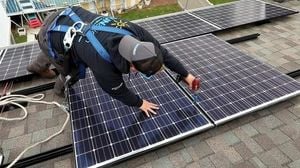As urbanization accelerates and environmental concerns rise, the demand for green living spaces in Vietnam is transforming the real estate landscape. More and more homebuyers are prioritizing eco-friendly features in their housing choices, marking a shift from traditional living standards.
Diệu Linh, a 32-year-old resident of Hanoi, reflects on her changing perspective regarding green living. "I used to think that trees in residential projects were merely decorative. But after visiting an apartment complex in Hà Đông with gardens, stone walkways, and naturally lit communal areas, my view of living environments completely changed," she shared.
This newfound appreciation for green spaces has driven many, including Linh's friend Vy, to save and invest in homes surrounded by nature. Vy, who moved further from the city center, expressed satisfaction with her decision, stating that her children now have a peaceful, green environment conducive to their growth and education. This trend is echoed by many homebuyers today, who are increasingly focused on environmental factors such as low building density, wastewater treatment systems, and green certifications like EDGE and LEED.
As Vietnam's major cities continue to rank among the most polluted in the world, the younger generation is more attuned to the importance of green living and environmental standards when choosing their homes. Tran Minh Khoa, a 38-year-old technology professional from Ho Chi Minh City, shared his experience: "Previously, I lived in a high-rise apartment in the city center and thought that buying a 'green' home was a luxury, more about aesthetics. However, after the pandemic and record heatwaves in Ho Chi Minh City, I decided to move to an urban area integrated with greenery, ecological lakes, solar energy, and environmentally friendly materials in District 2."
Initially attracted by the area's beauty and popularity, Khoa realized after a year that he did not want to return to his old lifestyle. He noted, "My electricity and water bills have decreased by nearly 40% since moving here, and my daughter suffers from fewer respiratory illnesses. I sleep better thanks to the cooler, less polluted air—unlike before when my air purifier had to work continuously. Living green is now a basic necessity for me." If he were to move again, Khoa emphasized that his first criterion would be the green aspect, including natural ventilation, open spaces, and the use of eco-friendly materials.
Despite facing challenges, the trend toward green real estate is deemed irreversible. Today's youth are not only seeking shelter but also a lifestyle where they can live healthily, sustainably, and responsibly towards the environment. According to Nguyen Dong Thanh, a civil engineer at Kien Truc Kien Thanh, green real estate encompasses more than just greenery; it requires a coordinated system that includes energy savings, environmentally friendly materials, optimization of natural light, and air quality assurance. These elements must be integrated from the construction phase through to operation.
However, Thanh pointed out that there are currently no mandatory standards for green projects in Vietnam. Consequently, some developers may mislead buyers by promoting aesthetically pleasing features like patches of grass or artificial lakes as 'green living' or 'European standard.' To avoid purchasing unsatisfactory homes, he recommends that buyers choose projects from reputable developers, check for credible green certifications, and survey the actual apartments.
A survey conducted by Batdongsan.com.vn at the end of 2024 revealed that over 86% of participants were interested in purchasing a green home, with 88% willing to pay a premium for it. This indicates that developing green projects is a sustainable competitive advantage for developers, fostering a friendly living environment and environmental protection. Vietnam has seen a significant increase in green buildings in recent years, with the EDGE certification system and the International Finance Corporation (IFC) revealing that the country currently boasts 559 projects with a total floor area of 13.6 million square meters certified as green, along with 31,384 apartments and 3,234 individual homes that have received green certification.
Dr. Nguyen Van Dinh, President of the Vietnam Real Estate Brokerage Association (Vars), noted that green-certified real estate projects tend to maintain better prices in the secondary market. As a result, green-certified apartments are viewed as effective investment options, offering better liquidity when consumers decide to switch properties. In fact, many green-certified housing projects have recorded stable price increases and maintained their value during market fluctuations. The World Green Building Council (WorldGBC) states that green buildings can increase overall asset value by up to 7% within five years. Experts believe that in the future, green living will not just be a choice but a necessary requirement. For real estate companies, green real estate is no longer a distant concept but a commitment to creating value for projects.
As the real estate market in Hanoi and Ho Chi Minh City evolves, the trend of moving towards suburban areas is gaining traction. Nguyen Van Hung, a 45-year-old man who moved from Thanh Xuan, Hanoi, to a newly purchased home in Dong Anh, illustrates this shift. After his divorce, he opted for a spacious living environment close to nature, stating, "I wanted a space that wasn't confined by concrete walls." His decision was supported by Hanoi's infrastructure plans, which have improved connectivity to suburban areas.
According to the Vietnam Association of Realtors, 85% of real estate transactions in Hanoi during the first quarter of 2024 occurred outside the city center. This reflects a shift in residents' preferences towards quality living spaces over central locations. The rising property prices in central areas, where a 70m² apartment in Gia Lam costs around 2.6 billion VND compared to over 5 billion VND in Cau Giay, have prompted many to seek homes in more affordable suburban regions.
Furthermore, the rapid development of transportation infrastructure, including projects like Ring Road 4 and the Nhon-Hanoi Railway, has facilitated this trend. These improvements have made it easier for residents to commute and live in suburban areas without significant inconvenience. Hung mentioned, "With the upcoming Tu Lien Bridge, the distance from my home to the West Lake area will become very short."
The emergence of new urban areas in the suburbs, equipped with various amenities, further attracts residents. For instance, the Vinhomes Ocean Park area has drawn over 50,000 residents within three years of its handover. However, the trend of moving away from the city center extends beyond individuals; businesses are also relocating due to high office rental costs in central locations.
Trinh Huynh Mai, Deputy Director of the Commercial Leasing Department at Savills Hanoi, stated that the scarcity of office space in the Hoan Kiem area has driven up rental prices, while competitive rates in suburban and near-central areas support the trend of moving away from the city center. After eight consecutive quarters of growth, the primary apartment market in Hanoi showed signs of stagnation in early 2025, with buyers increasingly moving to areas with reasonable prices and improving infrastructure, such as Van Giang in Hung Yen.
According to One Mount Group's market research center, primary supply reached about 4,000 units, with consumption at 3,000 units, reflecting a 60-70% decrease compared to the 11,000-12,000 units in the fourth quarter of 2024. This marks the first quarter since early 2023 that the market has seen a significant drop in both supply and consumption. Tran Minh Tien, Director of One Mount Group, noted that buyer sentiment is shifting. Many potential buyers are expanding their search radius due to high prices and financial constraints, seeking affordable options while ensuring quality living and connectivity.
As the market grapples with high prices and limited supply in the city center, the trend of moving towards satellite areas is becoming increasingly prominent. Areas like Van Giang in Hung Yen, located just east of Hanoi, stand to benefit significantly from improved regional transportation infrastructure and the emergence of large urban developments. One Mount Group forecasts that the eastern region will lead Hanoi's apartment supply from 2025 to 2026, with Van Giang accounting for 29% of the total market supply. Currently, prices in Van Giang are around 61 million VND/m², significantly lower than those in central Hanoi.
In conclusion, the growing preference for green living spaces and the shift towards suburban areas reflect a broader transformation in Vietnam's real estate market. As environmental consciousness rises and infrastructure improves, this trend is likely to continue, reshaping the future of urban living.




